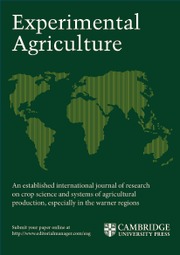Crossref Citations
This article has been cited by the following publications. This list is generated based on data provided by Crossref.
Tarimo, H. M.
and
Huxley, P. A.
1979.
A Preliminary Note on the Growth ofAmaranthus SP.At Morogoro, Tanzania.
East African Agricultural and Forestry Journal,
Vol. 44,
Issue. 3,
p.
183.
Marzola, D. L.
and
Bartholomew, D. P.
1979.
Photosynthetic Pathway and Biomass Energy Production.
Science,
Vol. 205,
Issue. 4406,
p.
555.
Ludlow, M. M.
1980.
Sago.
p.
128.
Monteith, J. L.
1981.
Climatic variation and the growth of crops.
Quarterly Journal of the Royal Meteorological Society,
Vol. 107,
Issue. 454,
p.
749.
Egli, D.B.
1981.
Species differences in seed growth characteristics.
Field Crops Research,
Vol. 4,
Issue. ,
p.
1.
WILD, A.
and
BREEZE, V.G.
1981.
Physiological Processes Limiting Plant Productivity.
p.
331.
STANHILL, G.
1981.
Physiological Processes Limiting Plant Productivity.
p.
39.
Chang, Jen-Hu
1981.
A climatological consideration of the transference of agricultural technology.
Agricultural Meteorology,
Vol. 25,
Issue. ,
p.
1.
Osmond, C. B.
Winter, K.
and
Ziegler, H.
1982.
Physiological Plant Ecology II.
p.
479.
Zelitch, Israel
1982.
The Close Relationship between Net Photosynthesis and Crop Yield.
BioScience,
Vol. 32,
Issue. 10,
p.
796.
Fasheun, A.
and
Dennett, M.D.
1982.
Interception of radiation and growth efficiency in field beans (Vicia Faba L.).
Agricultural Meteorology,
Vol. 26,
Issue. 3,
p.
221.
Corley, R. H. V.
1983.
Potential Productivity of Tropical Perennial Crops.
Experimental Agriculture,
Vol. 19,
Issue. 3,
p.
217.
Aggarwal, P.K.
and
Sinha, S.K.
1983.
Water stress and water-use efficiency in field grown wheat: A comparison of its efficiency with that of C4 plants.
Agricultural Meteorology,
Vol. 29,
Issue. 3,
p.
159.
LONG, S. P.
1983.
C4 photosynthesis at low temperatures.
Plant, Cell and Environment,
Vol. 6,
Issue. 4,
p.
345.
Loomis, R. S.
1983.
Physiological Plant Ecology IV.
p.
151.
LONG, S. P.
1983.
C4 photosynthesis at low temperatures.
Plant, Cell & Environment,
Vol. 6,
Issue. 4,
p.
345.
Jones, M.B.
1984.
Energy for Rural and Island Communities.
p.
355.
Drake, Bert G.
1984.
Light response characteristics of net CO2 exchange in brackish wetland plant communities.
Oecologia,
Vol. 63,
Issue. 2,
p.
263.
Frey, K.J.
1984.
Cereal Production.
p.
47.
WILSON, D.
1984.
Identifying and exploiting genetic variation in the physiological components of production*.
Annals of Applied Biology,
Vol. 104,
Issue. 3,
p.
527.

